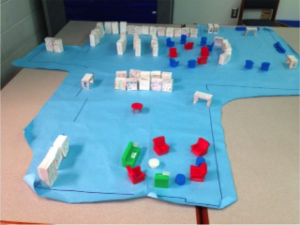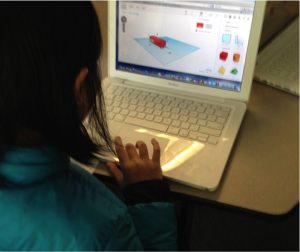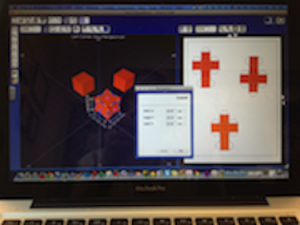Design Thinking, and a Library Update, With Third Graders
An elementary school librarian and her students reconceive their library to make it more conducive to Project Based Learning.

A scale model of the school library and its furnishings, with 3-D printed items.
My third graders helped me redesign my library. How? It started when our K–5 school in Albemarle County, VA, adopted STEAM-integrated Project-Based Learning (PBL), which engages students in learning through planning and completing a project. This was part of a a larger strategy to embrace 21st-century learning. We needed to evaluate our learning spaces so they could accommodate and invite PBL through application, creation, making, and tinkering. I took a leadership role in transforming our elementary school library into a model learning space, as well as a center of information. Collaborating with a third grade class, we attacked the challenge of transforming the library with a five-step design process.
Using TinkerCad to design library furnishings to scale.
Step 1: State the problem
“How can the library better meet the needs of our users?” That was the question I used to start discussions with my classes. Students determined that they needed to create a survey. Small groups shared questions with the whole group via a web graphic organizer. The final survey had two questions:- Why do you come to the library?
- What would you like to change or add to the library?
Step 2: Generate ideas

FabLab ModelMaker software.
We wrote survey responses on index cards and attached them with magnetic tape to our whiteboard, where they could be manipulated and grouped. As the class discussed the ideas, we realized how hard it was to visualize how the library should change. The students decided they needed a working model of the library, similar to a dollhouse, using a floor plan and movable furniture. Creating this scale model was also a great math exercise. They formed three groups to measure floor space, the fixed furniture, and the movable furniture. Students used metric measurements, with a scale of 1:20 cm. A record keeper in each group maintained a chart with the items’ actual measurements and scaled measurements. Now they were ready to create the model. Students drew the floor plan on bulletin board paper and cut it out. They used FabLab ModelMaker, software for designing a 3-D model using simple geometric shapes, and the digital fabricator, an electronic cutting machine, to create standard furniture, such as bookcases and tables. They printed other items, such as rocking chairs, with a 3-D printer, designing them with Thingiverse and TinkerCad. Students laid out the floor plan on a library table, taped down the fixed furniture, and arranged the movable furnishings. Staff and students manipulated furniture and wrote suggestions on index cards, which we used these for step three a week later.Step 3: Select Solutions
I reminded students that we had no money, and we prioritized the index card suggestions, attached with magnetic tape to the whiteboard, based on desirability and feasibility. With this prioritized list, we moved to step four.Step 4: Build
The index cards suggested changes to space, resources, and time.- Regarding space, users wanted space for individuals, small groups, whole classes, and multiage groups, as well as a maker space. We moved furniture to accommodate these flexible groupings. We also relocated furniture into the hallway in front of the library, basically annexing it as additional workspace. We turned the library work room and storage room into work spaces as well. Then we moved our storage room shelving into the library to hold fixed maker stations, called makertubs.
- Regarding resources, we started by identifying what we were using and eliminating what we weren’t, which freed up additional space. With the list of things to add, we identified items we could get through donations, such as LEGOs, and those we would need to purchase, such as robotics, through grants, PTO requests, and other sources.
- Regarding time, students wanted to be able to access the library and its resources any time. This input from our students facilitated the move from a completely fixed schedule to a hybrid schedule, with fixed for preschool through grade two and flexible for grades three to five. The plan has resulted in increases in circulation and use of library space.
Step 5: Evaluate

The reconceptualized school library,
At the end of the year, I repeated the initial survey to all my classes. Overwhelmingly, the responses indicated that these were positive steps, and patrons are excited about the transformation. Classroom teachers are also enthusiastic, citing how eager the students are to spend time in the library. Most importantly, this problem-based learning activity confirmed students’ ownership of the library, the power of their ideas, and the importance of the library to their daily work. Anita Mays is the PreS–5 librarian at Baker-Butler Elementary School in Charlottesville, VA.
Anita Mays is the PreS–5 librarian at Baker-Butler Elementary School in Charlottesville, VA. RELATED
RECOMMENDED
CAREERS
The job outlook in 2030: Librarians will be in demand
CAREERS
The job outlook in 2030: Librarians will be in demand
ALREADY A SUBSCRIBER? LOG IN
We are currently offering this content for free. Sign up now to activate your personal profile, where you can save articles for future viewing






Add Comment :-
Comment Policy:
Comment should not be empty !!!
Liz M.
This couldn't have come at a better time. My school is building a new library, and no staff input was allowed regarding building features or layout. District Execs (none with library experience) and the architects decided everything. HOWEVER shelving, fixtures, and furniture haven't been chosen yet, and I'm going to use this article as evidence when I advocate for a user-up design process. Thank you so very much!Posted : May 31, 2017 10:27
Florence Poor
I'm a jealous retired teacher who loved the librarian's creative ideas. I retired when MCAS caused my class to cry. What a wonderful gift for those children. They will never forget.Posted : May 31, 2017 02:03